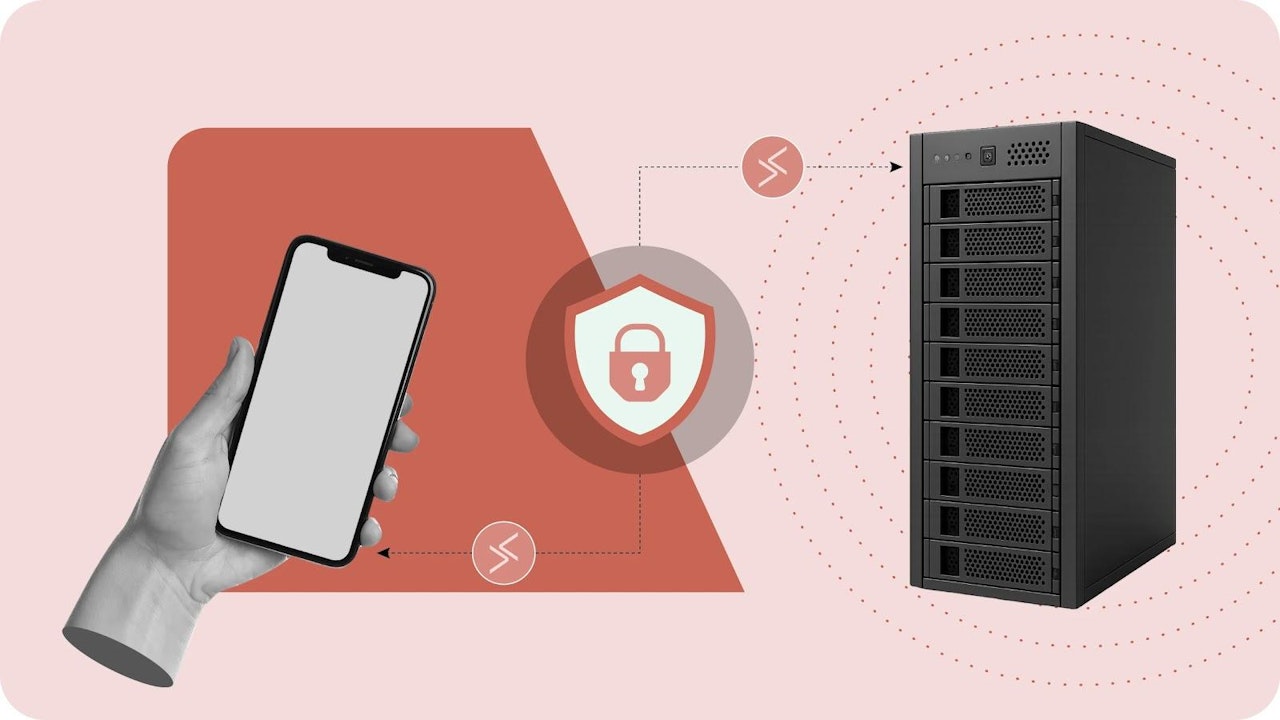According to Gallup, 27% of employees work fully remote, and 51% have a hybrid work environment. The increase of a remote workforce coupled with diverse network environments has necessitated a change in how organizations approach security.
Traditional network perimeters simply aren’t flexible enough to meet the demands of mixed and cloud-based network environments, which is why modern secure remote access solutions are essential.
Many of these modern secure remote access solutions, such as remote desktop tools, ZTNAs, SSEs, and SASE solutions, follow Zero Trust principles to provide continuous verification, least-privilege access, and improved protection against evolving threats.
Keep reading to learn more about the types of secure remote access solutions, what to look for in a solution, and the best choice for your organization’s needs. If you already have a baseline understanding of the different solutions, jump to our comparison of specific solutions below.
What option to choose?
Types of Secure Remote Access Technologies
Secure remote access solutions come in several forms, each with different strengths depending on your network setup, security priorities, and scalability needs. Here’s a quick overview of the main types to help you choose the right fit.
|
Solution Type |
Definition |
Best For |
Strengths |
Challenges |
Products |
|
Remote Access Software |
Remote control of physical devices over the internet |
IT support, hybrid employees that need access to specific devices |
Easy to deploy, cost-effective |
Few network access controls |
|
|
Business VPN |
Encrypted tunnels connecting users to network |
SMBs needing straightforward, secure access for applications |
Easy to deploy, strong encryption |
Less granular user controls |
|
|
Zero Trust Network Access (ZTNA) |
Identity- and context-based access control |
Businesses who want stricter controls and are adopting Zero Trust |
Fine-grained access control, strong security posture |
Slightly more complex to deploy and manage |
|
|
Security Service Edge (SSE) |
Security-only cloud services (ZTNA, CASB, SWG) |
Hybrid and cloud-based organizations who want identity-driven security |
Endpoint visibility, cloud security |
Doesn’t provide network connectivity |
|
|
Secure Access Service Edge (SASE) |
Integrated networking + security platform |
Distributed enterprises who need strong security |
Centralized policy, strong security |
Complex and costly implementation |
|
- Remote Access Software: Remote desktop tools let users securely access and control individual devices as if they were physically present. They're ideal for IT support, remote troubleshooting, and accessing on-premise resources. While they don’t manage app or network-level access like ZTNA or SASE, they’re lightweight, easy to deploy, and cost-effective for SMBs and teams with straightforward remote access needs. However, they can face compatibility challenges across different operating systems and struggle to scale efficiently in large or complex environments.
- Business VPN: Modern business VPNs go beyond traditional hub-and-spoke architecture, using mesh networks or cloud-based gateways to create encrypted tunnels between users and resources. They secure data in transit, mask IP addresses, and can support split tunneling and access segmentation. While VPNs provide a familiar remote access method, they may offer less granular user controls and visibility than other solutions. They're often best for SMBs or teams needing a simpler, fast-to-deploy option with strong encryption. However, they can conflict with other security solutions like firewalls, and can be difficult to manage and scale effectively across large teams.
- Zero Trust Network Access (ZTNA): A ZTNA solution secures access by continuously verifying user identity, device health, and contextual factors, never assuming trust. It’s ideal for organizations adopting a Zero Trust model and needing fine-grained access controls for distributed workforces.
- Security Service Edge (SSE): A SSE solution focuses on the security layer, delivering ZTNA, cloud access security broker (CASB), and secure web gateway (SWG) capabilities without the networking components. It’s suited for organizations prioritizing identity-driven access, cloud security, and endpoint visibility in a remote-first environment.
- Secure Access Service Edge (SASE): A SASE solution merges networking capabilities (like SD-WAN) with cloud-delivered security (such as ZTNA and firewall-as-a-service) into a single platform. It’s a strong fit for large or hybrid enterprises seeking centralized policy enforcement, broad scalability, and simplified security stack management.
Each solution type offers a different mix of features, so it’s important to understand your business needs and choose the option that aligns best. This next section helps you evaluate your options by listing the core features to weigh.
Essential Secure Remote Access Solution Features
Each secure remote access technology, whether it’s a modern VPN, ZTNA, SSE, or SASE, offers a different mix of security controls and capabilities. Understanding the core features behind these solutions can help you evaluate how well they align with your security goals, network environment, and user workflows.
While offerings vary by provider, the most effective solutions strike a balance between strong protection and a smooth user experience. Below are the essential features to look for.
User Authentication and Access Controls
- MFA/2FA: Requires multiple forms of identity verification, like a password and a mobile app code
- SSO: Allows users to log in once to access multiple apps centralizing authentication and making it easier to enforce strong access policies
- IAM: Manages who can access what, often with role-based permissions and activity monitoring
Device Security
- Endpoint security: Defends user devices from malware and intrusion
- End-to-end encryption: Secures data in transit.
- Private gateways and VPNs: Routes traffic through encrypted tunnels for data protection and to hide IP addresses
- Device posture checks: Validate device security
Deployment and Integration
- Hybrid environment support: Works across cloud and on-premises networks
- Ease of integration with existing tools: Integrates with existing tools in your network to provide access to and secure your tech stack
- Agent and agentless deployment options: Supports both agentless access for BYOD and unmanaged devices and agent-based access for deeper control, visibility, and policy enforcement on managed endpoints
- Scalability: Scales efficiently as your organization grows without adding significant overhead
Monitoring and Admin Controls
- Real-time user monitoring and anomaly detection: Provides visibility and flags unusual behavior quickly
- Comprehensive logging: Tracks user activity for auditing, compliance, and optimization
- Central policy management: Allows admins to enforce access policies efficiently
- Automated provisioning: Grants and revokes access based on user roles to reduce manual admin work
Cloud-Based Remote Access Tools
Cloud-based remote access tools are essential for a wide range of users, including IT support teams, remote workers, freelancers, managed service providers (MSPs), and educators.
These tools enable secure, real-time access to computers and networks from virtually anywhere, making them invaluable for troubleshooting, file access, or running software that’s only available on office machines.
1. Splashtop Remote Access

Best For: Organizations of all sizes, especially IT help desks and remote support teams, who need fast, secure, device-level access rather than full network or application-layer controls
Pros:
- Fast and consistent connection speeds
- Easy to deploy and use
- Supports secure, agentless access to internal systems via Splashtop Connector
- Session recording available for auditing and compliance
Cons:
- Core secure access features (like SSO and Connector) restricted to Enterprise tier
- Endpoint security is an add-on with an additional cost
- Lacks advanced ZTNA features like behavior analytics
Splashtop is a remote access and support software provider best known for device-level remote desktop connections. It’s relatively affordable at $8.25/month/user for the Pro plan and $13/month/user for the Performance plan.
Easy to implement and use, Splashtop has fast and consistent connection speeds across various network environments, ensuring a productive work experience for remote locations. The Splashtop Connector on the Enterprise Plan adds functionality for secure, agentless access to internal systems via RDP or VNC and the platform features extensive integration capabilities, allowing organizations to maintain their existing workflows alongside it. Security and compliance requirements are addressed through session recording, which enables detailed auditing and accountability.
But the platform has its flaws. Splashtop’s SSO functionality is only available through integrations and exclusively for enterprise subscribers, limiting authentication options for smaller organizations. Also, endpoint security is only available as an add-on at an additional cost, potentially increasing the total investment required by organizations.
Splashtop lacks features often associated with ZTNA and SASE platforms, such as IP masking, network-level controls, and fixed IP support. Most significantly, many essential secure remote access features are only available to enterprise subscription tiers, creating a clear functional divide between enterprise and non-enterprise customers and excluding many subscribers from full functionality.
Splashtop provides fast, secure, and easy remote access to individual devices, with enterprise-grade options for those who need advanced capabilities. It’s not a replacement for ZTNA or SASE platforms, but it is a practical and affordable solution for organizations prioritizing secure device access over network segmentation.
2. ScreenConnect by ConnectWise
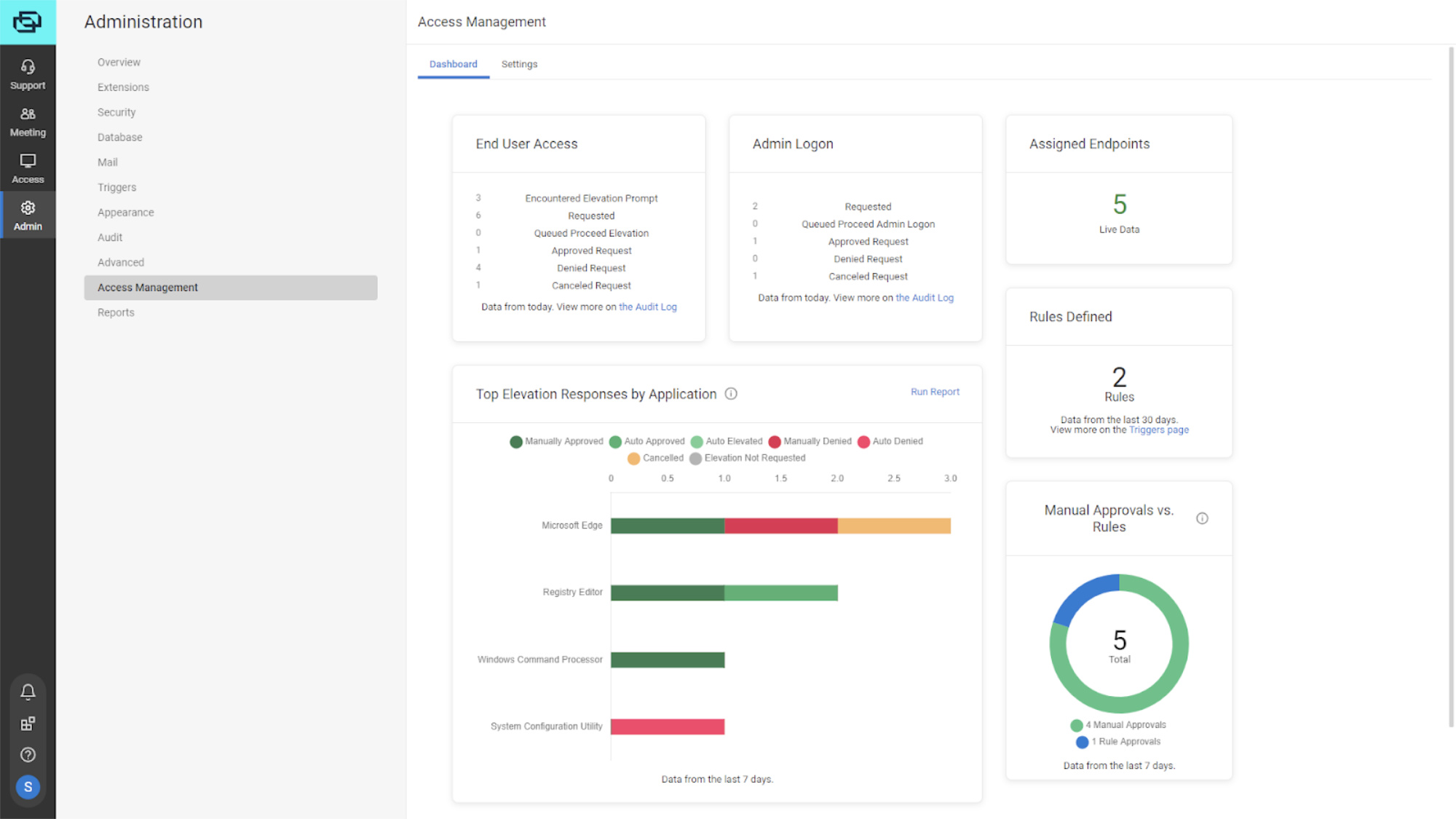
Best For: Mid-to-large organizations that need a secure, deeply customizable remote access platform with self-hosting and robust admin controls
Pros:
- Granular permissions and role-based access controls
- Strong audit trail and session logging capabilities
- Offers optional self-hosting for added control
Cons:
- 25-agent minimum with costly jumps between tiers
- Need third-party integrations for some core security features such as threat detection and log analysis
- Requires internal resources for oversight and configuration
- Some users report lags or slower speeds
ScreenConnect Remote Access is a flexible remote access platform built for IT teams and MSPs to securely manage devices from anywhere, with plans starting at $41/month for 25 agents.
It stands out for its advanced permissions, detailed auditing, deep customization, and support for automation. The Backstage feature allows technicians to perform command-line troubleshooting in the background without disrupting the user, while the Toolbox speeds up workflows by enabling quick deployment of preloaded scripts and files.
Security automation is strong, with both templated and custom triggers that flag abnormal events like invalid logins or session anomalies. Detailed audit logs, including geolocation data and automatic session recording, provide a strong paper trail for compliance and threat detection. ScreenConnect also supports deep branding and interface customization, along with optional self-hosting and agentless access, which is useful for managing devices like routers via SSH or Telnet.
While the solution is customizable, it requires significant internal oversight and IT management resources to maintain optimal functionality. It also has a 25-agent minimum, making it non-optimal for small businesses. Additionally, its licensing model can be expensive for growing businesses due to wide jumps between agent tiers (eg. 100 to 250). And some security measures, such as SSO, are only offered through integrations with third-party tools.
ScreenConnect is best suited for mid-sized to large IT teams or MSPs that need powerful customization, strong security auditing, and the flexibility of self-hosting, especially with in-house resources to manage the platform.
Business VPNs
Business VPNs offer a straightforward way to establish secure remote connections between employees and corporate resources. With features like centralized network access controls, dedicated IPs, and activity monitoring, business VPNs ensure that only authorized users can reach the internal network.
3. NordLayer by NordVPN

Best For: Small to mid-sized organizations that need a user-friendly solution they can easily implement and maintain
Pros:
- Ease of use
- Fast and consistent connection speed
- Flexible and transparent pricing
- Seamless integrations
Cons:
- Does not offer true agentless deployment
- Less comprehensive activity monitoring than some other solutions
- Automatic provisioning and deprovisioning is only available through integrations
NordLayer is a comprehensive secure remote access solution that is user-friendly and simple to deploy. Pricing starts at $10/user/month for the Lite plan, $14/user/month for the Core, and $18/user/month for the Premium when billed monthly.
At its core, it functions as a modern business VPN, but it layers in network-level security features to provide more robust protection. NordLayer supports encrypted tunnels, site-to-site connections, and network segmentation, allowing IT teams to restrict user access based on team, location, or function. It also offers features like biometric 2FA, SSO integration, and threat block capabilities to help organizations implement Zero Trust principles.
Smart Remote Access which creates a virtual LAN, enables secure device-to-device communication and file sharing across locations, which is ideal for remote collaboration without sacrificing security standards.
The platform’s interactive shared gateway map provides administrators greater visibility and simplified network management. Admins can easily see connection points, monitor traffic patterns, and identify potential issues before they become problems. Having this level of visibility is crucial for maintaining security in complex environments and significantly reduces the management burden compared to more traditional VPN solutions.
Despite strong overall performance, NordLayer’s support infrastructure shows some limitations. Users report that standard support channels can be slow or ineffective and often have to go directly to their account representatives to get timely and effective help.
Unlike some competitors, NordLayer doesn’t offer true agentless deployment options, requiring users to download and install the NordLayer software on their devices for remote access. However, they are developing an Enterprise Browser to help improve overall control and security and they have browser extensions for Chrome, Firefox, Microsoft Edge, and Brave.
NordLayer offers activity monitoring that shows user actions and connection activity, but the reporting is less granular than some other solutions. One built-in feature that’s missing from NordLayer’s comprehensive solution is automatic provisioning and deprovisioning, but they do offer this through integrations with tools so teams won’t miss this functionality.
With low user minimums, flexible pricing, and strong performance even under high load, NordLayer is especially well-suited for small to mid-sized businesses seeking scalable, user-friendly security safeguards.
4. Netbird
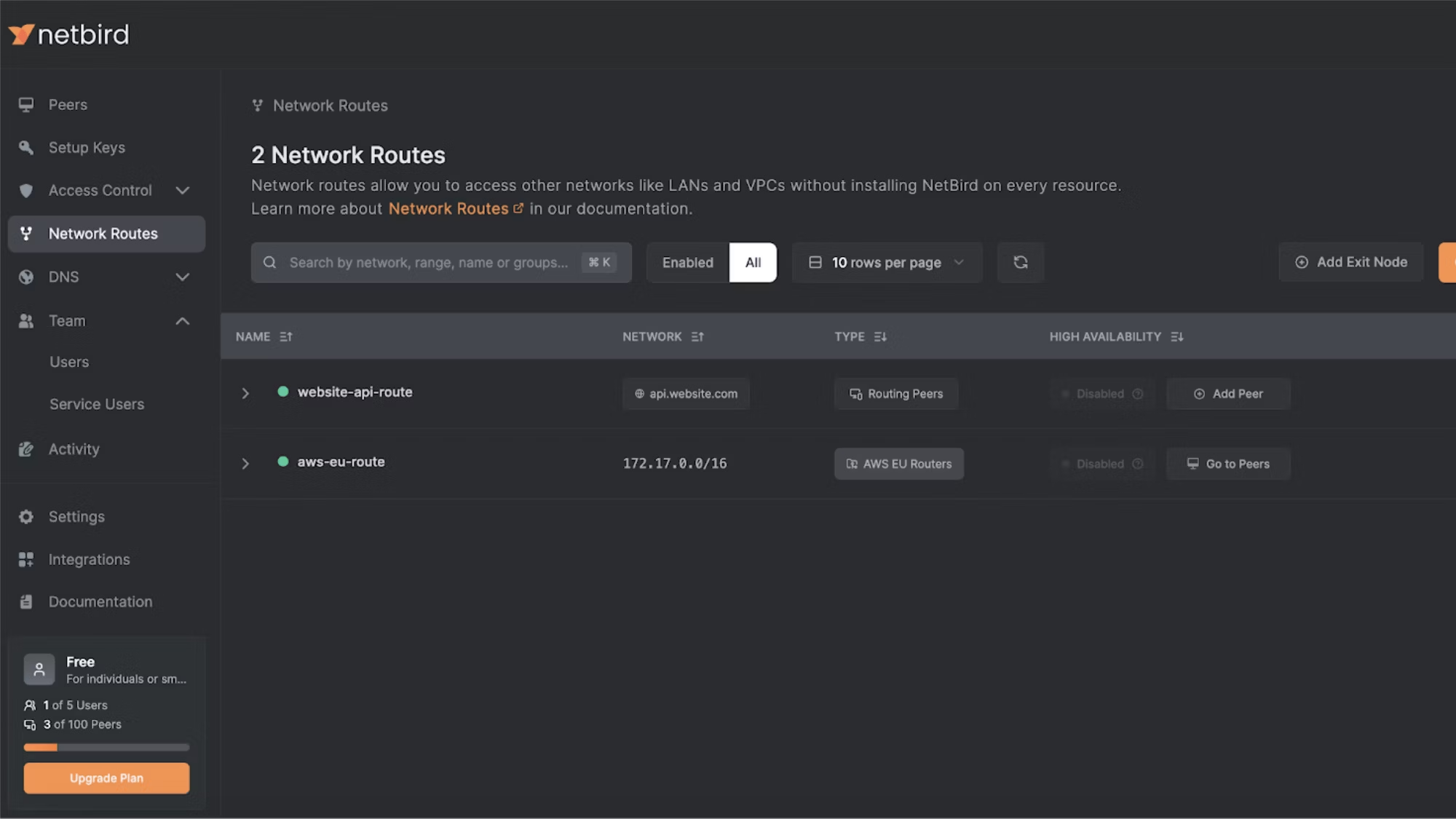
Best For: Small to mid-sized organizations who need a cost-effective, easy-to-use solution, and don’t need built-in logging, reporting, or threat detection
Pros:
- Free subscription tier for small team
- Self-hosted and cloud-based options
- Default IP masking
Cons:
- Requires some technical expertise for advanced customization
- Lacks robust user activity logging and centralized reporting
- Does not offer agentless deployment
- Limited integrations compared to other solutions
Netbird is a WireGuard-based secure access solution that creates a mesh network between devices, allowing secure peer-to-peer communication without relying on centralized gateways. The platform includes a free subscription tier that supports small teams, making it accessible for startups and small businesses with limited security budgets. Team plans are $5/user/month and Business plans are $12/user/month.
Its open-source nature allows teams to self-host and customize the platform to their needs, while the default cloud-hosted version offers a seamless onboarding experience with minimal configuration.
Netbird supports access control through groups and permission rules and automatically manages keys and NAT traversal, reducing the manual effort usually required with WireGuard. Netbird’s IP masking default enhances privacy and security during remote connections without requiring additional configuration. Users consistently report that the platform is easy to use, with an intuitive user interface.
While basic setup is simple, advanced use cases require manual configuration. Additionally, the platform’s security monitoring capabilities are limited, with user monitoring, threat detection, and reporting only available through third-party SIEM integrations rather than as built-in features. Because it doesn't have many integrations with identity providers, teams may need to handle provisioning manually or via API.
Unlike some competitors, Netbird does not support agentless deployment, necessitating software installation on all devices requiring secure access, which can increase administrative overhead and complicate support for BYOD environments.
Netbird is a cost-effective solution for engineering-focused teams that want fast, secure, peer-to-peer connectivity. Its open-source foundation and straightforward interface make it an appealing choice for teams comfortable managing basic infrastructure but who want an alternative to OpenVPN.
5. Cisco Secure Client (Formerly AnyConnect)

Best For: Enterprises that need a comprehensive solution and have in-house IT support, preferably with Cisco experience, to handle deployment and management
Pros:
- Strong and comprehensive suite of security features
- Seamless integration with Cisco security ecosystem
- Client-based and clientless access options
Cons:
- Many features available only through additional Cisco tool subscriptions
- Complex setup
Cisco Secure Client is a modular business VPN that consistently delivers reliable connections across mixed network environments, making it a dependable choice for enterprises with remote and hybrid workforces. The solution is easy to install and centrally manage.
Secure Client is designed to integrate with the broader Cisco security ecosystem, creating a unified security approach rather than disjointed point solutions. For example, Cisco Duo adds ZTNA capabilities, supporting context-aware and least-privilege access. Cisco Umbrella and Secure Endpoint enforce DNS-layer protection, malicious traffic blocking, and endpoint behavior monitoring.
These integrations enable comprehensive protection while maintaining visibility across the entire network infrastructure, ideal for organizations already invested in the Cisco ecosystem. While the modular structure allows you to put together a solution that fits your needs, many essential features require additional subscriptions.
User behavior tracking is only available through Cisco Secure Network Analytics at an extra cost. Similarly, multifactor authentication and single sign-on capabilities require a separate Cisco DUO subscription, adding to the total investment. Automated provisioning/deprovisioning is also only available through an additional subscription to Cisco Identity Services Engine (ISE).
Despite a reliable foundation, users report mixed experiences with connection speeds and reliability in certain network environments and limited compatibility with older operating systems.
The initial implementation tends to be complex, often requiring dedicated IT resources or professional services to optimize for the best outcomes.
Cisco Secure Client provides enterprise-grade access for remote users with strong security features and an extensive ecosystem of other tools that seamlessly integrate. However, the layered subscription and licensing costs quickly add up, especially for smaller and medium-sized businesses. Additionally, smaller teams may not have the resources to implement and optimize the tool for best performance.
Zero Trust Network Access (ZTNA) Solutions
ZTNA solutions apply the principle of "never trust, always verify." Rather than granting users broad network access like VPNs, ZTNAs connect authenticated users to specific apps without exposing the network. This reduces the amount of possible vulnerabilities and is an ideal choice for organizations embracing Zero Trust in hybrid or cloud-native environments.
6. Twingate
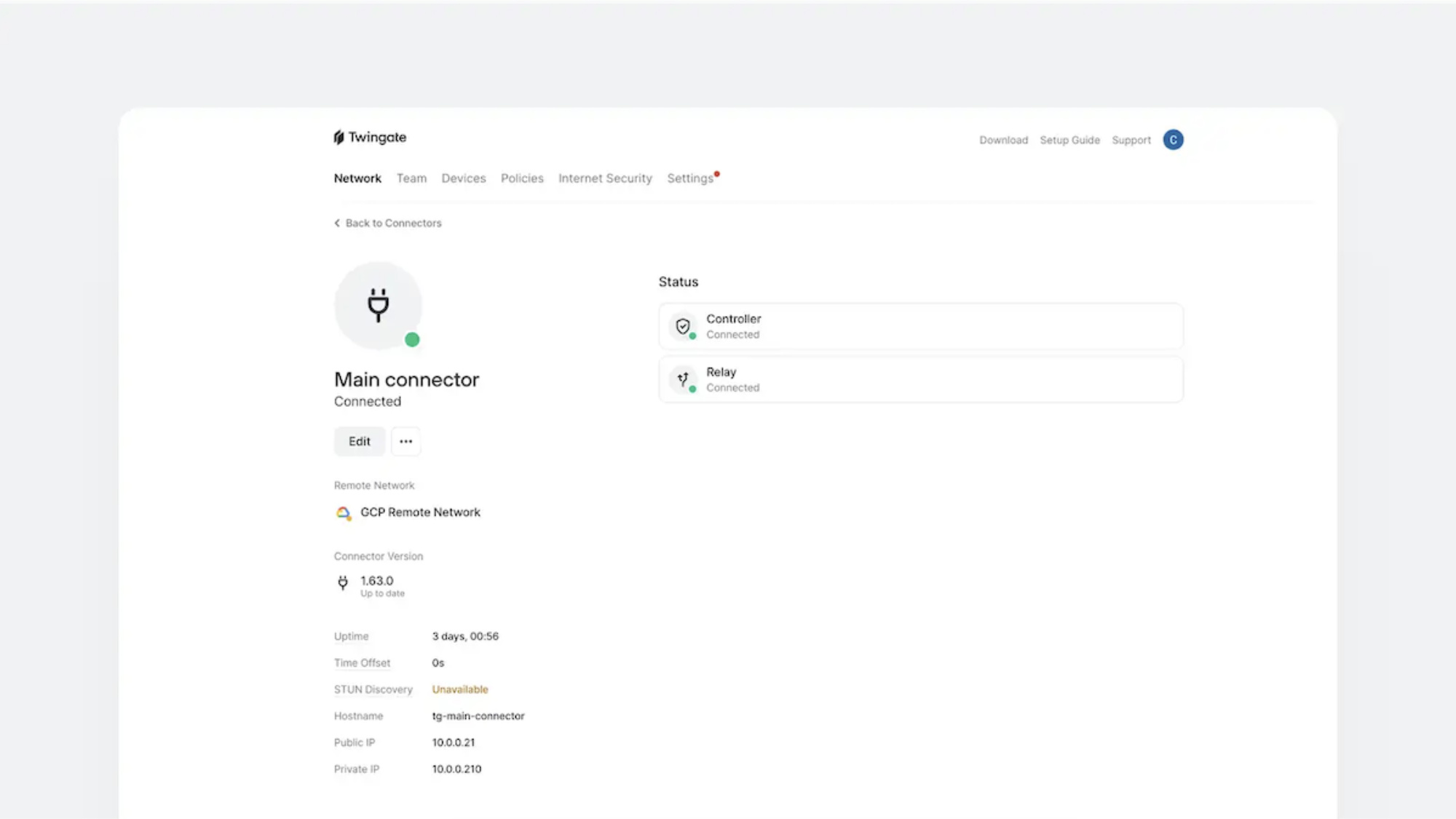
Best For: Organizations that need an fast and easy-to-implement ZTNA solution
Pros:
- Granular resource-level access controls
- No need for network reconfiguration
- Seamless user experience
Cons:
- Activity logging is limited without integrations
- No agentless solution
- Some advanced features limited to higher pricing tiers
Twingate provides a modern secure remote access solution that replaces traditional VPNs with a Zero Trust approach, authenticating users and devices before granting access to individual resources. One of its core strengths is the ability to deploy without touching existing network infrastructure. Administrators can implement Twingate with minimal changes, making it ideal for teams with limited IT bandwidth.
Twingate uses identity providers like Okta, Google Workspace, or Azure AD to enforce role-based access, and offers fine-grained access controls that allow teams to define who can access what, down to the individual service level.
Its smart routing optimizes speed and reliability by routing traffic through the fastest available path, making it noticeably smoother than traditional VPNs. The user-friendly interface makes it easy to manage resources, connectors, and policies.
However, monitoring and log retention capabilities are limited. To achieve deeper insights, Twingate recommends forwarding logs to external tools like Datadog or AWS S3. Log retention is limited by plan, with Starter plans only retaining logs for 24 hours and Business plans retaining logs for 30 days.
Lower-tier plans also don't support many integrations or have internet security features like DNS, plus they don't offer user-based, time-bound, or device only access policies. Most security features must be added on to Business and Enterprise plans for an extra fee.
Overall, Twingate is a modern, easy-to-use ZTNA that works well for growing teams that need secure remote access without overhauling existing networks.
7. Zscaler Private Access
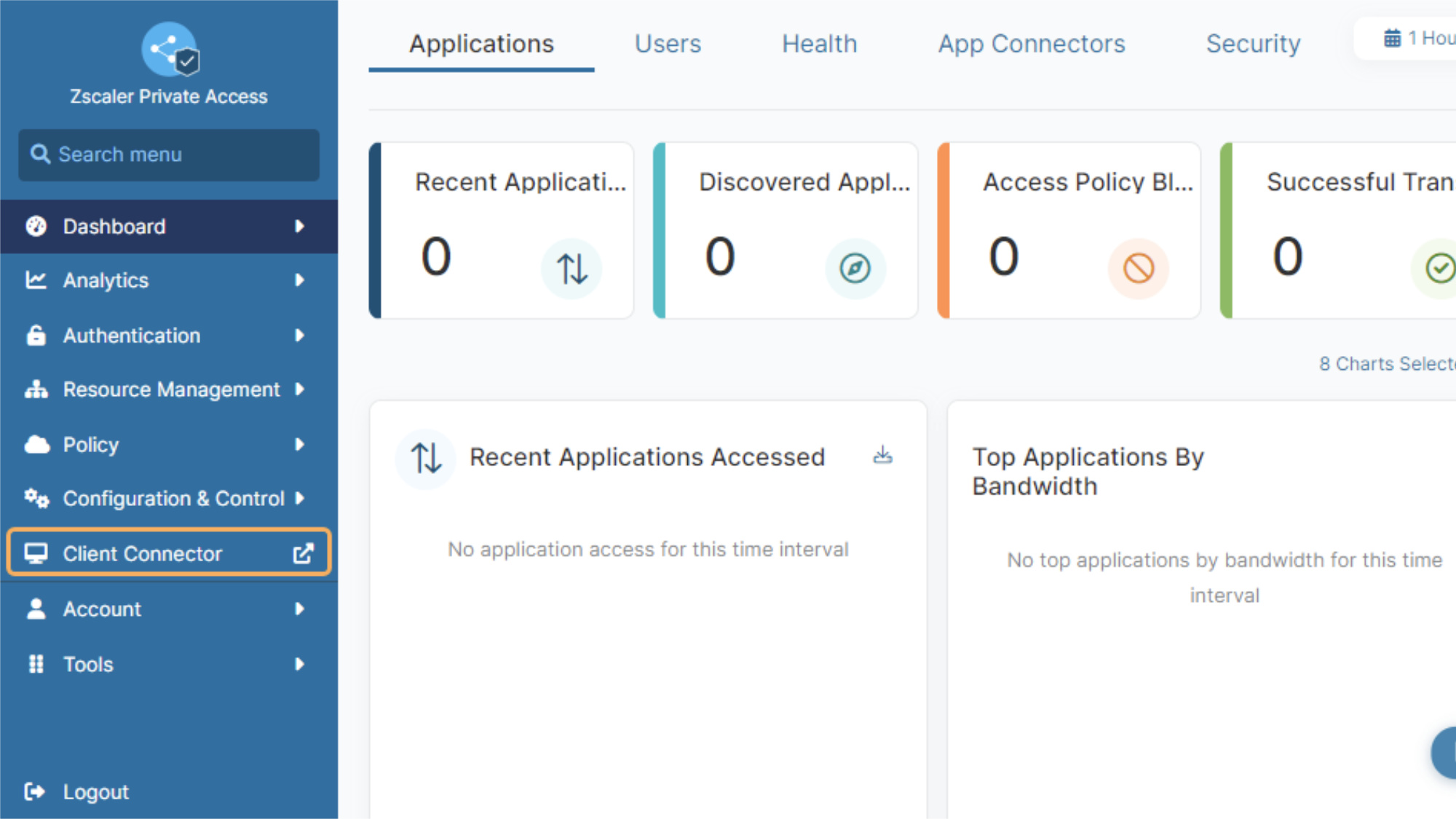
Best For: Tech-savvy enterprises requiring scalable Zero Trust access and robust security features
Pros:
- Free cybersecurity training
- Streamlined compliance reporting
- AI-powered analytics and threat protection
Cons:
- Complex initial setup
- High total cost of ownership
- Mixed reviews on performance and reliability
- Requires add-ons and third-party integrations for more advanced capabilities
Zscaler Private Access (ZPA) is a ZTNA that uses AI-powered app segmentation to generate recommended segments and policies. ZPA is praised for its advanced Zero Trust capabilities, particularly its ability to simplify compliance through detailed audit logging and reporting, helping enterprises meet frameworks like GDPR and HIPAA.
Its AI-driven analytics and real-time threat protection are also frequently cited as major advantages by users in regulated industries. Additionally, Zscaler Academy offers free cybersecurity training that helps IT teams maximize their investment in the platform and improve overall security posture.
But Zscaler has its downsides. A significant limitation of ZPA is that anomaly detection capabilities are only available as a separate service at an additional cost, requiring organizations to increase their investment for comprehensive security. Similarly, IAM functionality is only offered through integrations with third-party providers like Okta, adding complexity and additional expense.
Multiple users report that the solution is expensive compared to alternatives, especially when accounting for all the add-ons needed for a complete feature set. Implementation challenges are common — users describe the setup process as complex and time-consuming and reviews are mixed regarding ease of use even after initial configurations.
Overall, Zscaler ZPA delivers enterprise-grade Zero Trust access with strong compliance features, threat protection, and valuable training resources. It will also allow your company to eventually scale up to a full SASE solution. However, its high cost, implementation complexity, reliance on add-ons, and inconsistent user experience may make it a less attractive option for mid-sized businesses or teams seeking simplicity.
SSE and SASE Solutions
SSE (Security Service Edge) focuses on cloud-delivered security capabilities like secure web gateways, cloud access security brokers (CASB), Zero Trust Network Access (ZTNA), and firewall-as-a-service.
SASE (Secure Access Service Edge) builds on this by adding a networking layer, typically SD-WAN, to create a unified framework for secure, high-performance connectivity.
These solutions simplify the enforcement of consistent, context-aware policies across users, devices, and cloud applications, allowing organizations to modernize access and security.
8. Harmony SASE by Checkpoint
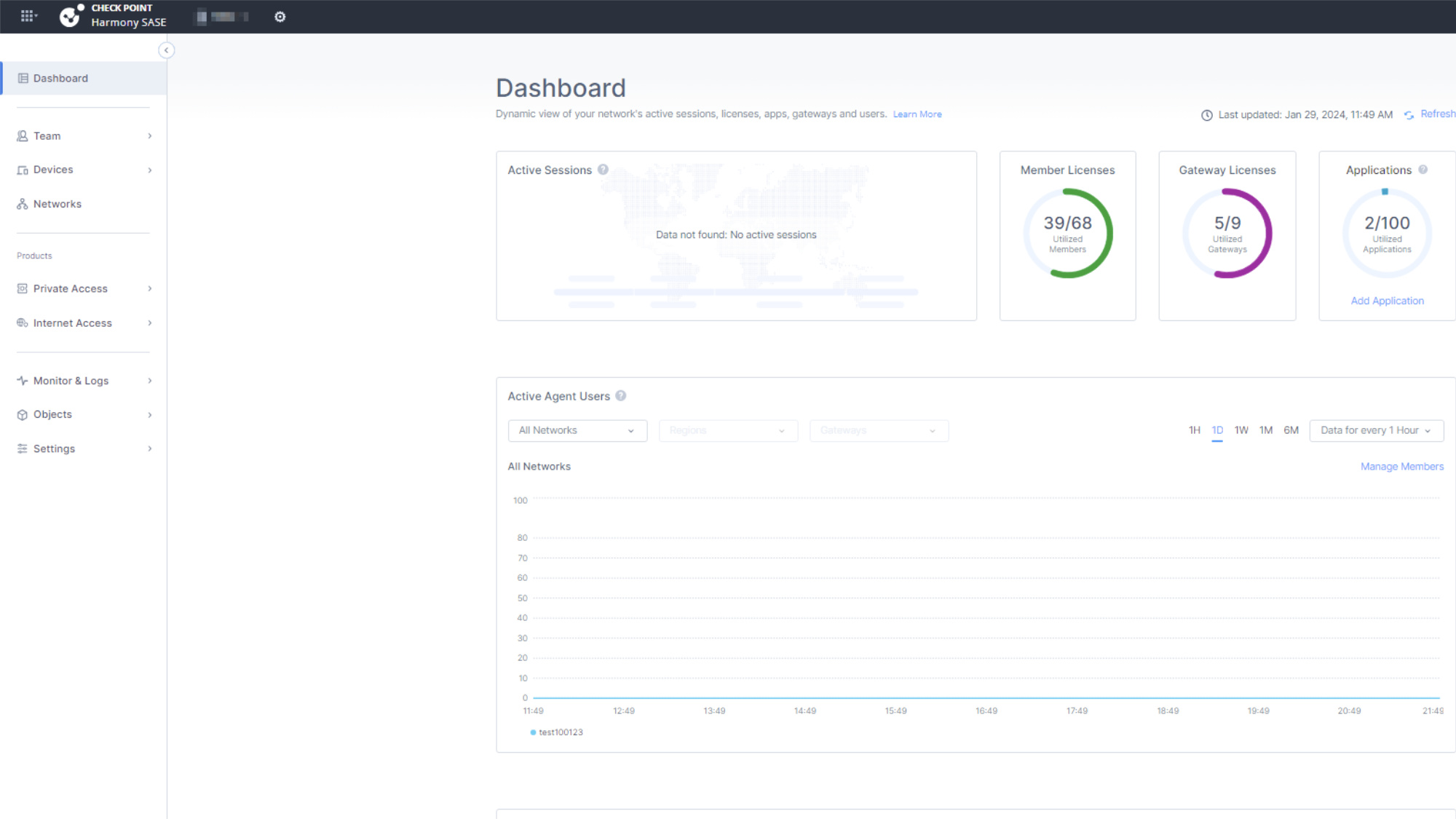
Best For: Mid-sized businesses that need an easy-to-use solution with foundational security features
Pros:
- Easy to implement and use
- Agent and browser-based access options
Cons:
- Poor customer support
- Less advanced security features than competitors
Harmony SASE (formerly Perimeter 81) is an entry-level SASE solution designed for ease of use and quick deployment, making it a solid option for mid-sized businesses or lean IT teams. It offers both agent-based and browser-based access, allowing organizations to secure remote connections on managed and unmanaged devices.
The platform includes basic SASE functionality like ZTNA, firewall-as-a-service, and web filtering, though some advanced features, such as endpoint protection, require third-party integrations.
While not as robust or customizable as some enterprise-level solutions, Harmony SASE provides a clean interface, straightforward policy management, and flexible deployment models that appeal to teams without deep security expertise.
However, users have reported inconsistent customer support and limitations around in-platform endpoint security, which may be considerations for more complex environments. Still, for organizations prioritizing simplicity and core Zero Trust features, Harmony SASE offers a manageable, accessible path to secure remote access.
9. Prisma Access by Palo Alto Networks
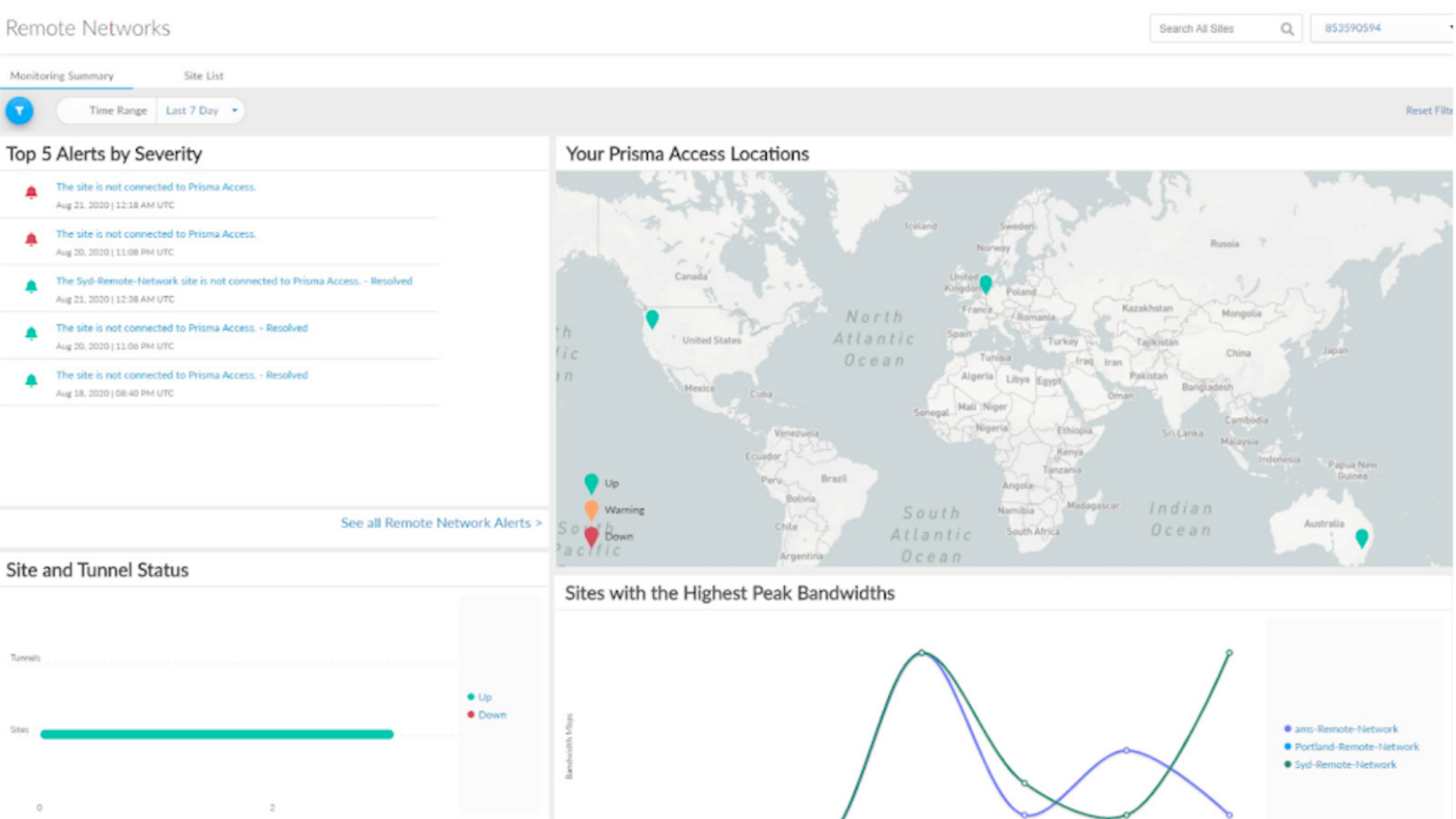
Best For: Enterprises with complex security requirements that have the internal IT expertise to implement and maintain the solution
Pros:
- Enterprise-grade threat detection and prevention
- AI-powered behavior analysis
- Agent and browser-based access
Cons:
- Complex setup, implementation, and optimization
- High cost
- 200-user minimum for most licenses
Prisma Access integrates Zero Trust Network Access (ZTNA), firewall-as-a-service (FWaaS), DNS security, and advanced threat prevention into a single, scalable platform. It offers exceptionally granular policy control with the distinctive ability to customize logging for each security policy, allowing organizations to fine-tune their monitoring.
The platform integrates with a wide range of third-party tools and identity providers, enabling organizations to maintain their existing security ecosystem while enhancing remote access capabilities.
Prisma Access leverages machine learning and Palo Alto's threat intelligence cloud (AutoFocus and WildFire) to identify and block known and unknown threats in real time. It also integrates with other Palo Alto Networks solutions like Cortex XDR and Panorama for unified policy management and extended detection and response (XDR).
While Prisma Access is more powerful than many other competitors, it is also much more complex to set up and manage, requiring experienced network professionals. And some features are only available through integrations. For example, authentication features like MFA and SSO are only available through third-party integrations like Okta.
Its pricing structure is premium and licensing minimums are 200 users, making this suited for enterprises over small businesses. As you stack different features and solutions, the total cost of ownership increases.
Prisma Access is ideal for enterprises that need cloud-delivered secure access at scale and want to unify remote connectivity with a comprehensive security stack. It’s an extremely strong solution, though complexity and cost can be a barrier.
Benefits of Secure Remote Access Solutions
Beyond simply enabling secure off-site work, secure remote access solutions offer a multitude of advantages to modern companies — namely, keeping sensitive data safe, and helping distributed teams stay flexible and productive.
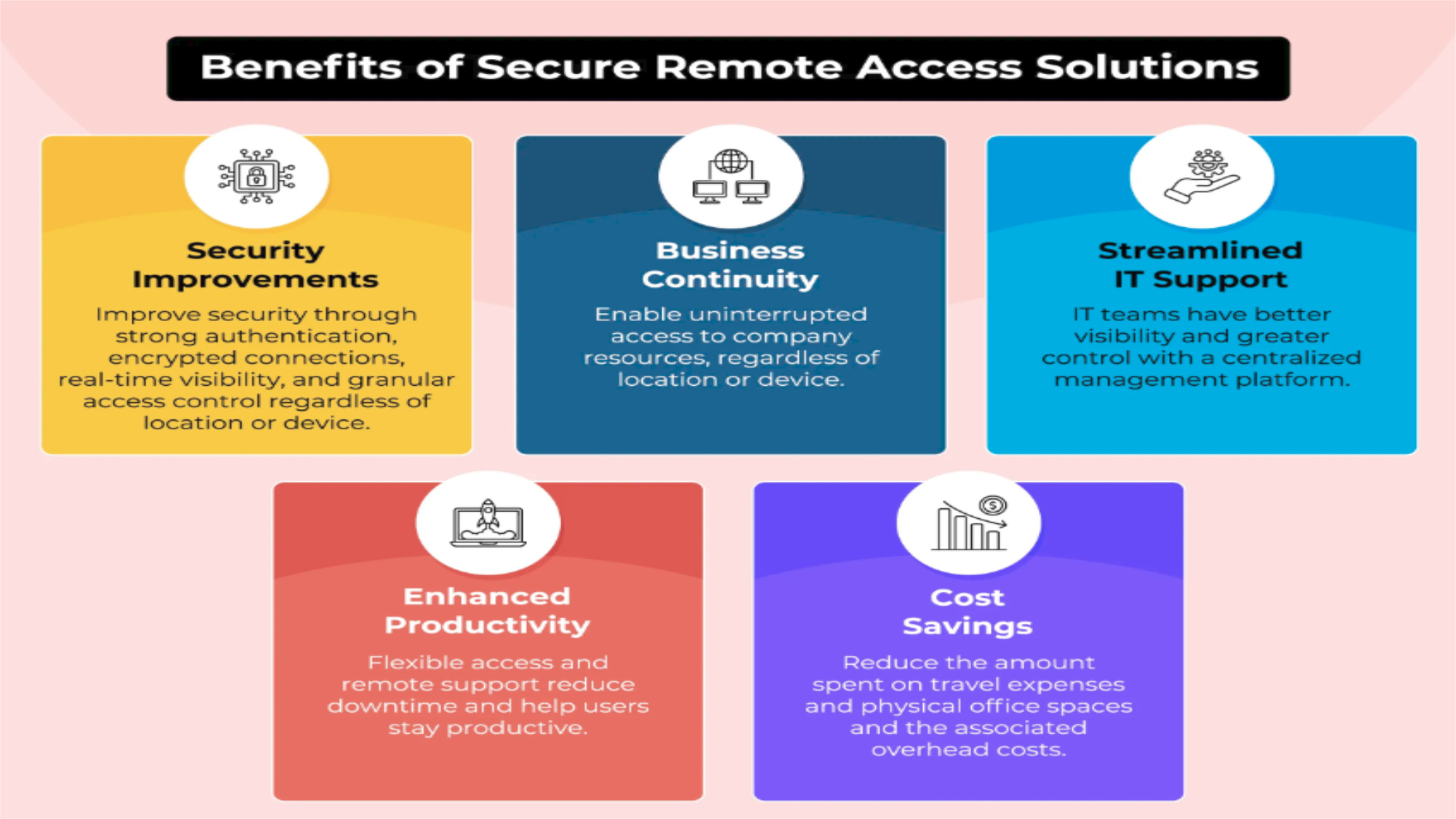
- Business continuity: Enable uninterrupted access to company resources, regardless of location or device. Typical disruptions like weather events or travel restrictions that would typically prevent critical access when users are unable to access the company network directly will no longer be an issue.
- Enhanced productivity: Users no longer have to worry about geographic constraints when accessing company resources, which allows for more flexibility in work schedules and conducting critical work away from the office as needed. Additionally, when support teams can access devices remotely, they are able to provide more timely help, decreasing system downtime.
- Cost savings: Reduce the amount spent on travel expenses and physical office spaces and the associated overhead costs.
- Security improvements: A strong secure remote access solution will improve security through strong authentication, encrypted connections, real-time visibility, and granular access control regardless of location or device.
- Streamlines IT support: IT teams have better visibility and greater control with a centralized management platform. It also simplifies software deployments and updates, and makes managing support tickets more efficient.
What option to choose?
Choosing the Right Secure Remote Access Solution for Your Organization
The best secure remote access solution is different for every organization, you should consider your organization’s specific needs, existing infrastructure, security requirements, and budget constraints. The solutions reviewed in this guide offer varying strengths and weaknesses, with some solutions prioritizing ease of use (like NordLayer) and others focusing on enterprise-grade security and customization at a higher price tag (like Prisma Access). The right choice ultimately depends on your organization’s unique requirements.
As cyber threats continue to become more sophisticated, and network environments become more complex, it’s essential that organizations implement strong secure remote access solutions. These solutions empower your workforce and protect your resources in today’s dynamic environment.
